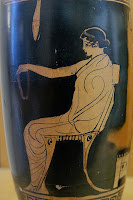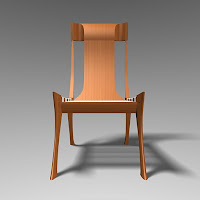 |
| image credit |
For one thing, I remember translating klismos as "easy chair" in my first Greek reading class. Seeing what an austere, if graceful, thing it is, I'm amused that we talked about them as though they were La-z-boy recliners. I also love the idea that they're still part of modern furniture design. It's reassuring to classicists whenever we find a bit of the ancient world in an unexpectedly modern setting.
-2.jpg) |
| Recreation of a Greek klismos (credit) |
Klismoi first appear in Homer and later in classical art like the vase-painting above. The curved back provides support and the curved legs are very stable, although they may spread out and break if too much weight is put on them.
Klismos chairs were revived in the eighteenth-century neoclassical period, first as props for historically-themed paintings and later as everyday furniture.
 |
| Neoclassical chair based on klismos (credit) |
Amazon lists several modern klismos chairs (shockingly expensive). "Design by Todd" considers how they could be used in a modern house, ultimately concluding that they are best employed as a "statement piece" or a "sculpture" -- too deep to sit in comfortably.
No comments:
Post a Comment